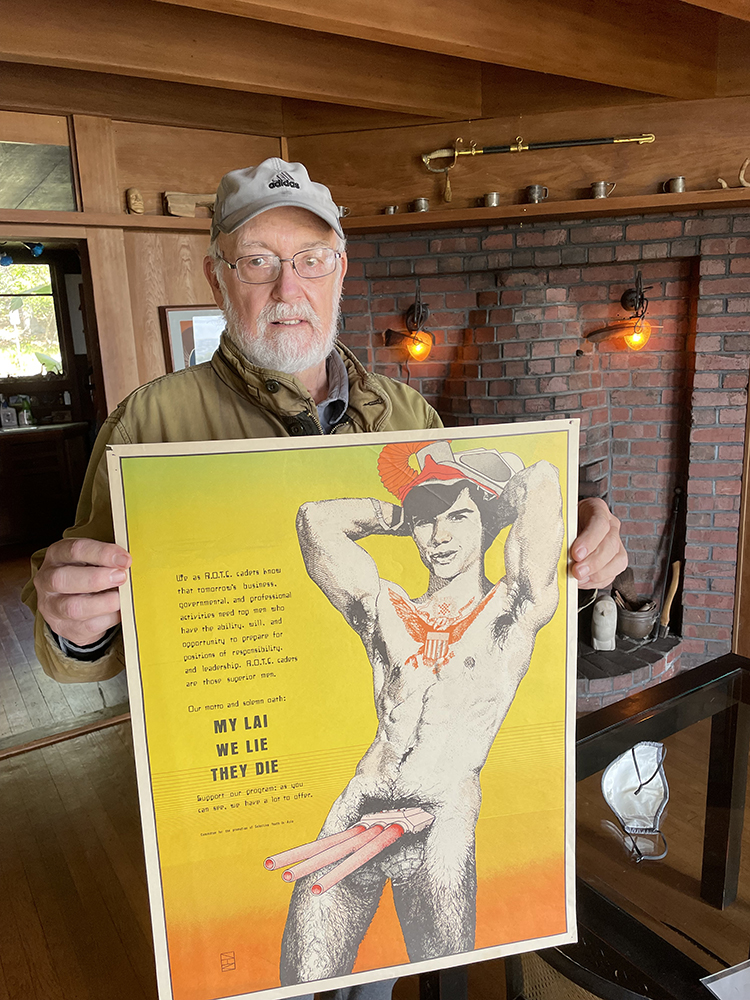“My Lai, We lie, They die” 1970
Lincoln Cushing interview and photo 5/3/2022
My Lai. The 1968 massacre of Vietnamese civilians by US troops, covered up by the military and revealed by journalists the next year, was a turning point in US tolerance of that terrible war.

Jeff Kramm was an architecture student at UC Berkeley from 1967 to 1970. The spring of 1970 all college campuses erupted in protest against the escalation of the Vietnam War and the domestic killings at Kent State and Jackson State – and the campus basically closed down for conventional instruction and was taken over to produce posters, flyers, and other media.
Apolitical Jeff became radicalized. He’d admired World War II soldiers and their sacrifice, but felt that in this war young men were unwitting pawns. In 1970 being gay still didn’t have much visibility or history. “The poster was my attempt at expressing, from that point of view, how I felt about sending off young men – gay or straight - to kill and be killed as extra tragic.”
Even with a brother in law enforcement, he was moved to make his own poster against the ROTC (Reserve Officers’ Training Corps) recruitment on the campus. Working at his desk in Wurster Hall, he took text verbatim from a ROTC flyer and added the concise poem slogan “My Lai, We lie, They die.” The layout was technique old school, with the soldier figure drawn from a photo and the typography painstakingly composed with transfer lettering. Despite the growing presence of alternative print shops, he took it to a conventional shop next to the campus who suggested he add Zipatone shading and color. “I was surprised the printer agreed to print the poster, and with no comment.“ He didn’t put his own name on it (instead, the poster uses a logo with a mirror image of the word MEN, which he uses to this day) for fear of retaliation from ROTC and “other like-minded individuals.” The poster remained “anonymous” until 2011, when the All Of Us of None collection went online at the Oakland Museum of California and he contacted me.
He only printed 200, and never thought it would be popular. He dropped a stack at Wurster, and a few got posted around the campus. It was displayed in an exhibition of protest art at the student union, but by the time Jeff got there all that was left was a shred – it had been torn down.
Years later, he reflects on the difficulty of that experience: “I didn't live in a world where I knew anyone to even discuss being gay. My close friends, family, no one I knew was there for that conversation. My artwork, like that poster, I thought would initiate the conversation with friends and family, but it didn't. Straight people aren't really interested in gay issues, I found, and don't really notice them. It was several years later before I came across anyone who could relate to the topic and was willing to discuss it. I did want to be sure there was a queer element in the My Lai poster, the naked man was that, so it would be clear, to my mind, that a queer person made it. Or so I thought at the time, not sure if anyone got that message.”
Jeff produced a few more political posters, but ended up getting an MFA in Painting and Drawing from the California College of the Arts and pursued a career as a fine artist. He lives in Oakland.
Return to Docs Populi / Documents for the Public